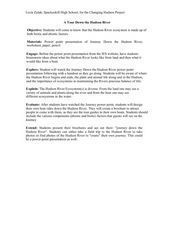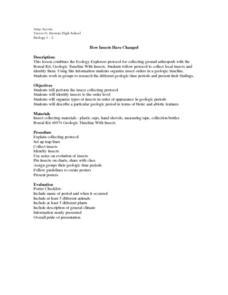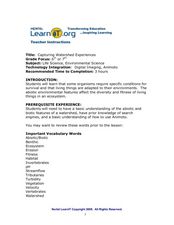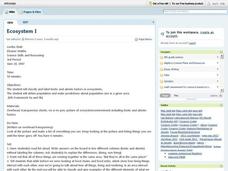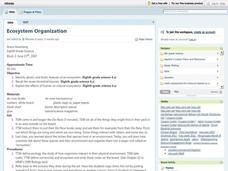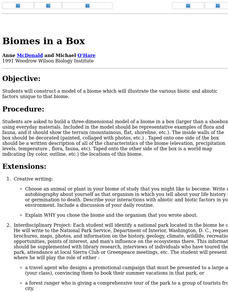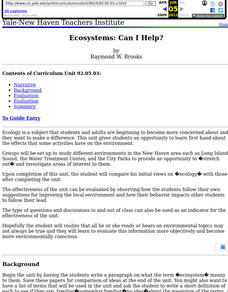Curated OER
A Tour Down the Hudson River
Students discuss how the Hudson River is an ecosystem made up of both biotic and abiotic factors. They view the PowerPoint the Journal Down the Hudson River. Students become aware of where the Hudson River begins and ends, the plant and...
Curated OER
How Insects Have Changed
Students work in groups to research the different geologic time periods and present their findings. They perform the insect collecting protocol, identify insects to the order level, and organize types of insects in order of appearance in...
Curated OER
Capturing Watershed Experiences
Students observe organisms found in the water. In this lesson on organisms, students collect water from local streams and tributaries in order to study the organisms found in the water. As a culminating activity, students create a...
Curated OER
Counting Animal Populations
Students learn how to count animal populations by the Mark and Recapture method. In this counting animal populations lesson plan, students begin by predicting amounts of different candies in a jar. Students then simulate using beans, two...
Curated OER
Ecosystems at School
In this ecosystem worksheet, students use a string and make a large circle. Everything in the circle is part of the ecosystem the students will study. They identify everything in their ecosystem and classify their data. They answer 2...
Curated OER
Succession in a Jar
In this succession worksheet, students build an ecosystem using a jar, water, bird seed, soil and a water plant. They predict what their ecosystem will look like in 3 weeks and draw a diagram. Students record their data over the course...
Curated OER
The Language of Science
In this language of science worksheet, students use the list provided to guess the meaning of each of the list. Students apply root words, prefixes, and suffixes to gain meaning of other science words.
Curated OER
Communities and Biomes
In this communities worksheet, high schoolers will look at the interactions between biotic and abiotic factors and the effect these factors have on organism populations. Students will also order the succession steps that occur over time...
Curated OER
Living and Nonliving Environments
In this ecosystem worksheet, students will distinguish between the abiotic factors and biotic factors shown in a diagram. Then students will correctly order the following: population, ecosystem, community, and organism.
Curated OER
Forest Fires
High schoolers discuss the benefits and problems associated with fire. They discuss the role that fire plays in maintaining healthy ecosystems. Students brainstorm ways that fire can be harmful, such as damaging homes, communities, and...
Curated OER
TE Activity: Environmental Interactions
Students design a web that shows the interactions between the living and non-living parts of the environment. They determine what an environment is and how engineers work together to solve problems. They complete a tally chart that they...
Curated OER
Flowering Phenology: How Do Plants Know When To Flower?
Students explore the biotic and abiotic factors that affect plant reproduction and the potential consequences of human activities on plant populations. The effects of urbanization are discussed as an influence in the consequences.
Curated OER
To Be or Not to Be - Abiotic/Biotic Factors
Students define and compare/contrast abiotic and biotic factors presented while using web cameras on the Web World Wonders website.
Curated OER
Forest Management ~ Diseases and Pests that Effect a Good Harvest Stand
The forestry presentation found here lists and describes a variety of tree diseases. A few unappetizing photos are included to show symptoms of some of these diseases, or the insects and fungi that cause them. If you have a class that is...
Curated OER
A Walk in the Woods
Eighth graders observe and identify the different levels of the forest. In this forest zones lesson students observe, identify and name a variety of forest components and describe how humans impact the forest ecosystem.
Curated OER
Chewin' in the Chesapeake
High schoolers examine a web page on food webs and select a habitat to research. In this research lesson students identify the organisms found in the food web and present their findings to the class.
Curated OER
Ecosystem I
Learners classify and label biotic and a-biotic factors in ecosystems. They define population and make predictions about population size in a given area. They describe the a-biotic factors' importance and impact on the other elements...
Curated OER
Habitats, Abiotic v. Biotic
Students explore and define ecosystem, ecology and habitat. They discuss abiotic and biotic organisms and the things needed for survival. After observing pictures of animals in their habitat, students compare and contrast habitats and...
Curated OER
Ecosystem Organization
Eighth graders engage in a lesson about ecosystems with the intention of looking at how it is organized. They cover the biotic and abiotic factors of an ecosystem while looking at the seven types of terrestrial biomes. Students write...
Curated OER
What Is In The Water?
Students investigate the biotic and abiotic factors that are found in an aquatic ecosystem. The emphasis is upon the investigation of present an projections of future water quality. Then students visit a local body of water to gather...
Curated OER
Biotic vs. Abiotic Factors
Learners share their prior knowledge of the elements of the environment. In groups, they are introduced to the concepts of biotic and abiotic factors in a specific environment. They discover their effects on organisms living in the...
Curated OER
Biomes in a Box
Students construct a three-dimensional model of a biome which illustrates the various biotic and abiotic factors unique to that biome. They use everday materials to represent the important characteristics of a particular biome and then...
Curated OER
Fascinating Factors
Learners observe biotic and abiotic things participating in an observational walk outside the school. They create a collage using pictures of biotic and abiotic items.
Curated OER
Ecosystems: Can I Help?
Students study how some activities effect the environment and ecosystems.


